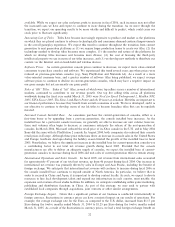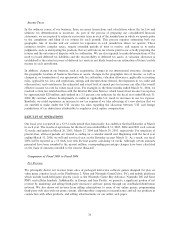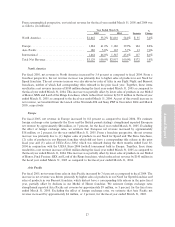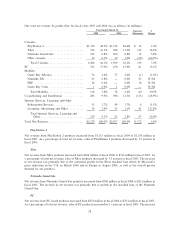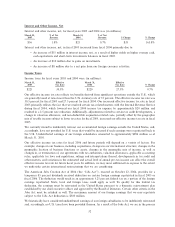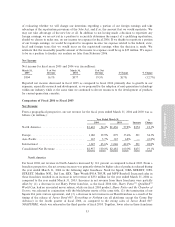Electronic Arts 2005 Annual Report Download - page 81
Download and view the complete annual report
Please find page 81 of the 2005 Electronic Arts annual report below. You can navigate through the pages in the report by either clicking on the pages listed below, or by using the keyword search tool below to find specific information within the annual report.
professional sports organizations, movie studios and other organizations for our use of their trademark,
copyright, personal publicity rights, content and/or other intellectual property. Royalty payments to indepen-
dent software developers are payments for the development of intellectual property related to our games. Co-
publishing and distribution royalties are payments made to third parties for delivery of product.
Royalty-based payments made to content licensors and distribution aÇliates generally are capitalized as
prepaid royalties and expensed to cost of goods sold at the greater of the contractual or eÅective royalty rate
based on net product sales. Prepayments made to thinly capitalized independent software developers and co-
publishing aÇliates are generally in connection with the development of a particular product and, therefore,
we are generally subject to development risk prior to the general release of the product. Accordingly, payments
that are due prior to completion of a product are generally expensed as research and development as the
services are incurred. Payments due after completion of the product (primarily royalty-based in nature) are
generally expensed as cost of goods sold at the higher of the contractual or eÅective royalty rate based on net
product sales.
Minimum guaranteed royalty obligations are initially recorded as an asset and as a liability at the contractual
amount when no signiÑcant performance remains with the licensor. When signiÑcant performance remains
with the licensor, we record royalty payments as an asset when actually paid rather than upon execution of the
contract. Minimum royalty payment obligations are classiÑed as current liabilities to the extent such royalty
payments are contractually due within the next twelve months. As of March 31, 2005 and March 31, 2004,
approximately $51 million and $63 million, respectively, of minimum guaranteed royalty obligations had been
recognized.
Each quarter, we also evaluate the future realization of our royalty-based assets as well as any unrecognized
minimum commitments not yet paid to determine amounts we deem unlikely to be realized through product
sales. Any impairments determined before the launch of a product are charged to research and development
expense. Impairments determined post-launch are charged to cost of goods sold. In either case, we rely on
estimated revenue to evaluate the future realization of prepaid royalties. If actual sales or revised revenue
estimates fall below the initial revenue estimate, then the actual charge taken may be greater in any given
quarter than anticipated. As of March 31, 2005, we had $135 million of royalty-related assets and
$1,483 million of unrecognized minimum commitments not yet paid that could be impaired if our revenue
estimates change.
Valuation of Long-Lived Assets
We evaluate both purchased intangible assets and other long-lived assets in order to determine if events or
changes in circumstances indicate a potential impairment in value exists. This evaluation requires us to
estimate, among other things, the remaining useful lives of the assets and future cash Öows of the business.
Annual Report
These evaluations and estimates require the use of judgment. Our actual results could diÅer materially from
our current estimates.
Under current accounting standards, we make judgments about the recoverability of purchased intangible
assets and other long-lived assets whenever events or changes in circumstances indicate a potential
impairment in the remaining value of the assets recorded on our consolidated balance sheet. In order to
determine if a potential impairment has occurred, management makes various assumptions about the future
value of the asset by evaluating future business prospects and estimated cash Öows. Our future net cash Öows
are primarily dependent on the sale of products for play on proprietary video game consoles, hand-held game
players and PCs (collectively referred to as ""platforms''). The success of our products is aÅected by our ability
to accurately predict which platforms and which products we develop will be successful. Also, our revenue and
earnings are dependent on our ability to meet our product release schedules. Due to product sales shortfalls,
we may not realize the future net cash Öows necessary to recover our long-lived assets, which may result in an
impairment charge being recorded in the future. We did not record any asset impairment charges in Ñscal
2005. During Ñscal 2004 and 2003, we recognized less than $1 million and $66 million, respectively, of asset
impairment charges.
25









